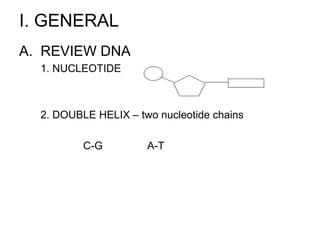
4. cell division
- 1. I. GENERAL A. REVIEW DNA 1. NUCLEOTIDE 2. DOUBLE HELIX – two nucleotide chains C-G A-T
- 2. II. CELL CYCLE A. GENERAL MITOSIS 1. DIAGRAM G2 G1 S
- 3. 2. DEFINITIONS a. DNA – A double helix molecule polymer with genetic information. b. GENE – A segment of DNA that codes for a specific trait. c. CHROMATIN – Uncondensed structures made of DNA & proteins found in the nucleus with genes on it.
- 4. d. CHROMOSOME – A condensed structure of DNA & proteins found in the nucleus with genes on it. Gene 1 Gene 2 Gene 3 1 chromosome 1 chromosome 1 chromatid = a single DNA molec. 2 chromatids = two DNA molec.
- 5. e. DIPLOID – An individual (cell, etc.) has 1 pair of chromosomes with the same genes. The chromosomes can have 1 or 2 chromatids each. or f. HAPLOID – An individual (cell, etc.) has 1 chromosome with specific genes. The chromosome can have 1 or 2 chromatids each. or
- 6. g. HOMOLOGOUS PAIR – two chromosomes in a single cell that have the same genes. Found in diploid organisms. Homologous pair where the Homologous pair where the chromosomes of the pair have only chromosomes of the pair have one chromatid. two chromatids.
- 7. B. PROKARYOTIC CELL DIVISION BINARY FISSION
- 8. C. EUKARYOTIC CELL CYCLE C1. INTERPHASE – 90% cell life – Where the cell spends most of its life
- 9. C2. CELL DIVISION (2 TYPES) Mother cell Daughter cells MITOSIS MEIOSIS 1. DIVIDE 2. # TIMES 1 2 3. WHERE (humans = all cells) (humans=gonads) 4. FUNCTION replace old cells sexual reproduction growth asexual reproduction
- 10. Interphase
- 11. MITOSIS A. PHASES – diploid organism prophase metaphase anaphase telophase & cytokinesis
- 12. Prophase 1. Chromatin into chromosomes 2. Nuclear envelope disintegrates 3. Spindle fibers form near the nucleus and some attach to kinetochores 4. Centrioles start to move to opposite poles.
- 13. Metaphase Chromosomes line up along the equator.
- 14. Anaphase The spindle fibers are shortened at the kinetochore which causes the chromatids to be pulled apart and moved to opposite poles.
- 15. Telophase Chromatids are at opposite poles, start to reform nuclear membrane, spindle fibers start to disappear.
- 16. CYTOKINESIS In animal cells the membrane pinches off to form 2 new cells, reform chromatin and nucleus .
- 17. Overall
- 18. III. MEIOSIS - general Two cell divisions where the resulting daughter cells have ½ the number of chromosomes as the originals. 23 23 MI MII 23 46 23 23 23
- 19. Prophase I of Meiosis I Nuclear membrane starts to disintegrate. Chromatin to chromosomes. Centrioles move. Form spindle fibers. Homologous Pairs form chiasma where can get crossing-over (exchange of genetic material) = recombination
- 20. Metaphase I of Meiosis I Homologous pairs line up along the equator. Independent Assortment – the chromosomes arrange themselves independent of the other homologous pairs. Type of recombination.
- 21. Anaphase I of Meiosis I The spindle fibers shorten and pull apart the chromosomes of the homologous pairs.
- 22. Telophase I of Meiosis I The chromosomes reach opposite poles and start to form nuclear membrane and disintegrate spindle fibers.
- 23. Cytokinesisand start to form The chromosomes reach opposite poles nuclear membrane and disintegrate spindle fibers. Divide cell contents. The two new cells each contain ½ the number of chromosomes as the original cell (each chromosome has two chromatids).
- 24. Prophase of Meiosis II Re-condense chromosomes if they uncondensed and replicate the centrioles. Spindle fibers form and centrioles move to opposite poles.
- 25. Metaphase of Meiosis II Chromosomes line up along equator. Spindle fibers attached.
- 26. Anaphase of Meiosis II Spindle fibers exert force to pull chromatids apart.
- 27. Telophase of Meiosis II Chromosomes reach the opposite poles and start to reform nuclear membranes.
- 28. Cytokinesis Split the cell contents so that end up with four haploid cells.